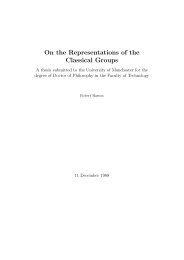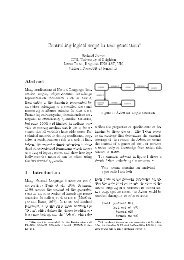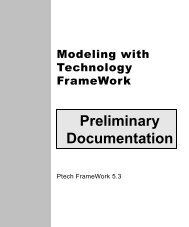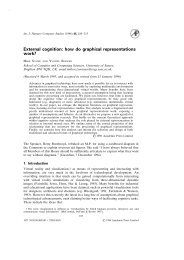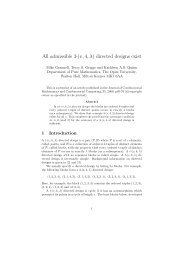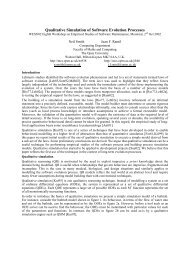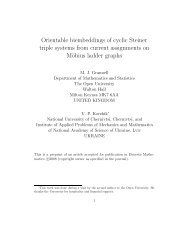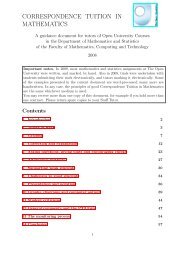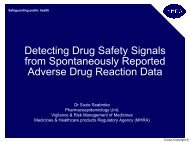03 Miller Soil Physics meeting.pdf
03 Miller Soil Physics meeting.pdf
03 Miller Soil Physics meeting.pdf
You also want an ePaper? Increase the reach of your titles
YUMPU automatically turns print PDFs into web optimized ePapers that Google loves.
New measurement methods in soil physics: future frontiers<br />
How soil physical conditions affect root<br />
development and nitrate uptake<br />
Tony <strong>Miller</strong>, Nick Chapman, Keith Lindsey, Richard Whalley
Plant biologist’s root methods<br />
• Hydroponically grown plants<br />
• Agar Petri dish<br />
• Sand culture<br />
• <strong>Soil</strong>
ROOT PROLIFERATION AND TRANSPORTERS<br />
> Root architecture > Nutrient distribution<br />
> Transporter activity > <strong>Soil</strong> strength<br />
MASS FLOW AND DIFFUSION<br />
> Water uptake > Hydraulic conductivity<br />
> Net ion uptake > Water potential<br />
> Plant demand > Ion mobility<br />
> Diffusion gradient<br />
Root nutrient acquisition<br />
Plant traits and soil physical properties<br />
LOW<br />
HIGH<br />
KEY<br />
Water movement<br />
Passive water uptake<br />
Active water uptake<br />
Nutrient ion uptake<br />
Nutrient ion efflux<br />
Substrate particle<br />
(Chapman et al., TiPS, 2012 in press)
Root nutrient acquisition<br />
<strong>Soil</strong> physical properties<br />
(Chapman et al. 2012, TiPS, submitted)
Arabidopsis root nutrient acquisition in sand rhizotrons<br />
Experimental approach<br />
Novel sand rhizotron system<br />
aspirator<br />
h, cm<br />
rhizotron<br />
funnel<br />
(Chapman et al. 2011, PC&E)
Arabidopsis root nutrient acquisition<br />
Physical characterisation of the root growth environment<br />
Water release characteristic<br />
sand<br />
graduated<br />
burette<br />
L, cm<br />
h, cm<br />
Q, cm/s<br />
water<br />
sand<br />
funnel<br />
Saturated hydraulic conductivity<br />
h, cm
Water content (cm 3 cm -3 )<br />
5.00<br />
4.50<br />
4.00<br />
3.50<br />
3.00<br />
2.50<br />
2.00<br />
1.50<br />
1.00<br />
0.50<br />
0.00<br />
(Chapman et al. 2011, PC&E)<br />
Arabidopsis root nutrient acquisition<br />
Physical characterisation of the root growth environment<br />
k (m/d-1)<br />
3.50<br />
3.00<br />
2.50<br />
Redhill T (measured)<br />
Redhill T (modelled)<br />
425 um (modelled)<br />
2.00<br />
1 10 100 1000<br />
1.50<br />
Matric potential (-hPa)<br />
1.00<br />
0.50<br />
0.00<br />
1.00E-01<br />
Redhill T 425 µm<br />
Relative hydraulic conductivity<br />
1.00E-<strong>03</strong><br />
1.00E-05<br />
1.00E-07<br />
1.00E-09<br />
1.00E-11<br />
Matric potential (-hPa)<br />
1 10 100 1000<br />
Redhill T<br />
425 um
Sand<br />
Arabidopsis root nutrient acquisition<br />
Physical characterisation of the root growth environment<br />
Water potential<br />
(MPa)<br />
Matric potential<br />
(kPa)<br />
Measured K sat<br />
(m.d -1 )<br />
Calculated K unsat<br />
(m.d -1 )<br />
Redhill T -0.11 -1.5 - 1.35<br />
Redhill T -0.33 -3.0 1.81 0.79<br />
Redhill T -0.40 -4.5 - 0.18<br />
425 μm -0.33 -3.0 3.23 0.17
Primary root length (PRL)<br />
Lateral root density (LRD)<br />
Arabidopsis root nutrient acquisition<br />
Root proliferation<br />
PRL (mm)<br />
LRD<br />
30.0<br />
25.0<br />
20.0<br />
15.0<br />
10.0<br />
5.0<br />
0.0<br />
0.20<br />
0.16<br />
0.12<br />
0.08<br />
0.04<br />
0.00<br />
**<br />
30.0<br />
25.0<br />
20.0<br />
15.0<br />
10.0<br />
5.0<br />
0.0<br />
0.20<br />
0.16<br />
0.12<br />
0.08<br />
0.04<br />
0.00<br />
*<br />
*<br />
30.0<br />
25.0<br />
20.0<br />
15.0<br />
10.0<br />
5.0<br />
0.0<br />
0.20<br />
0.16<br />
0.12<br />
0.08<br />
0.04<br />
0.00<br />
**<br />
**<br />
(Chapman et al. 2011, PC&E)
Arabidopsis root nutrient acquisition<br />
Relating root proliferation to physical properties of the sand<br />
PRL response conserved response to water potential and hydraulic<br />
conductivity<br />
Lateral root growth strongest relationship with hydraulic conductivity<br />
Percentage of roots with laterals<br />
80<br />
75<br />
70<br />
65<br />
60<br />
55<br />
50<br />
K unsat (m.d -1 )<br />
r 2 = 0.93<br />
45<br />
0.0 0.2 0.4 0.6 0.8 1.0 1.2 1.4 1.6<br />
30.0<br />
25.0<br />
20.0<br />
15.0<br />
10.0<br />
5.0<br />
0.0<br />
PRL (mm)<br />
*<br />
30.0<br />
25.0<br />
20.0<br />
15.0<br />
10.0<br />
5.0<br />
0.0<br />
PRL (mm)<br />
**<br />
(Chapman et al. 2011, PC&E)
Root proliferation<br />
Arabidopsis root nutrient acquisition<br />
Root proliferation conclusions<br />
Primary root length increases with decreasing water supply and this is<br />
independent of nitrate concentration at the root surface<br />
Lateral root number, length and density increase with increasing nitrate<br />
concentration but decrease with decreasing water supply<br />
Root proliferation and soil physical characteristics<br />
Primary root length increases with decreasing hydraulic conductivity and<br />
increasingly negative water potential<br />
Lateral root number, length and density increase with nitrate<br />
concentration but also increased hydraulic conductivity and less negative<br />
water potential
Localisation of<br />
NRT (nitrate) and<br />
AMT (ammonium)<br />
uptake genes in<br />
Arabidopsis<br />
Shoot<br />
NO3 -<br />
NO 3 -<br />
NO 3 - NO3 -<br />
?<br />
NO 3 -<br />
NO 3 -<br />
NO 3 -<br />
NO 3 -<br />
NO 3 -<br />
NO 3 -<br />
NO 3 -<br />
?<br />
NO 3 -<br />
NO 3 -<br />
NO 3 -<br />
NO 3 -<br />
NO 3 -<br />
NRT1.1 NRT1.2; NRT2.1; CLC; NRT1.5; NAXT1;<br />
Phloem; Xylem; Vacuole; Cells; <strong>Soil</strong>;<br />
Modified from Masclaux-Daubresse et al. 2010
Root nutrient acquisition<br />
Root transporters<br />
ROOT BULK<br />
NO 3 -<br />
NO 3 -<br />
NO 3 -<br />
NO 3 -<br />
LOW<br />
NO 3 -<br />
NO 3 -<br />
NO 3 -<br />
NO 3 -<br />
NO 3 -<br />
[NO 3 - ]<br />
NO 3 -<br />
NO 3 -<br />
NO 3 -<br />
NO 3 -<br />
NO 3 -<br />
NO 3 -<br />
NO 3 -<br />
HIGH
Arabidopsis root nutrient acquisition<br />
Root transporters<br />
Do soil physical changes influence root transporters?<br />
AtNRT1.1 – dual-affinity nitrate uptake (and sensor)<br />
AtNRT2.1 – high-affinity nitrate uptake<br />
AtPIP2.2 – plasma membrane root aquaporin (drought response)<br />
AtPIN1 – basipetal vascular auxin efflux (root elongation)<br />
AtPIN2 – acropetal epidermal and basipetal cortical auxin efflux (lateral<br />
root growth)
Using Arabidopsis to understand root nutrient acquisition<br />
Gene expression<br />
0.100 AtNRT2.1<br />
0.080<br />
0.060<br />
0.040<br />
0.020<br />
0.000<br />
0.100<br />
0.080<br />
0.060<br />
0.040<br />
0.020<br />
0.000<br />
*<br />
AtPIP2.2<br />
*<br />
0.100 AtNRT2.1<br />
0.080<br />
0.060<br />
0.040<br />
0.020<br />
0.000<br />
0.100 AtPIP2.2<br />
0.080<br />
0.060<br />
0.040<br />
0.020<br />
0.000<br />
*<br />
0.100<br />
0.080<br />
0.060<br />
0.040<br />
0.020<br />
0.000<br />
0.100<br />
0.080<br />
0.060<br />
0.040<br />
0.020<br />
0.000<br />
AtNRT2.1<br />
*<br />
AtPIP2.2<br />
*
Using Arabidopsis to understand root nutrient acquisition<br />
Gene expression<br />
0.100<br />
0.080<br />
0.060<br />
0.040<br />
0.020<br />
0.000<br />
0.080<br />
0.060<br />
0.040<br />
0.020<br />
0.000<br />
AtNRT2.1<br />
*<br />
0.100 AtPIP2.2<br />
0.100 AtNRT2.1<br />
0.080<br />
0.060<br />
0.040<br />
0.020<br />
0.000<br />
0.100<br />
0.080<br />
0.060<br />
0.040<br />
0.020<br />
0.000<br />
*<br />
AtPIP2.2<br />
*<br />
0.100 AtNRT2.1<br />
0.080<br />
0.060<br />
0.040<br />
0.020<br />
0.000<br />
0.100 AtPIP2.2<br />
0.080<br />
0.060<br />
0.040<br />
0.020<br />
0.000<br />
*<br />
0.100 AtNRT2.1<br />
0.080<br />
0.060<br />
0.040<br />
0.020<br />
0.000<br />
0.100<br />
0.080<br />
0.060<br />
0.040<br />
0.020<br />
0.000<br />
*<br />
AtPIP2.2<br />
*
Arabidopsis root nutrient acquisition<br />
Root transporters tagged with GFP (green fluorescent protein)<br />
16x 50x 256x
0.100 AtNRT2.1<br />
0.080<br />
0.060<br />
0.040<br />
0.020<br />
0.000<br />
*<br />
0.100 AtNRT2.1<br />
0.080<br />
0.060<br />
0.040<br />
0.020<br />
0.000<br />
*<br />
Arabidopsis root nutrient acquisition<br />
Root transporters<br />
proAtNRT2.1:eGFP line was a gift to AJM from Kiba Takotoshi (Riken Institute, Japan)<br />
-1.5 kPa -4.5kPa WT<br />
425 µm WT
Arabidopsis root nutrient acquisition<br />
Root transporters – using mutant plants lacking specific genes<br />
35.0 PRL (mm)<br />
30.0<br />
25.0<br />
20.0<br />
15.0<br />
10.0<br />
5.0<br />
0.0<br />
7.0<br />
6.0<br />
5.0<br />
4.0<br />
3.0<br />
2.0<br />
1.0<br />
0.0<br />
*<br />
*****<br />
TLRL (mm) *****<br />
****<br />
2.5 LRN<br />
2.0<br />
1.5<br />
1.0<br />
0.5<br />
0.0<br />
0.14<br />
0.12<br />
0.10<br />
0.08<br />
0.06<br />
0.04<br />
0.02<br />
0.00<br />
*<br />
*<br />
*****<br />
LRD *****<br />
**<br />
***
Root transporters<br />
Arabidopsis root nutrient acquisition<br />
Root transporter conclusions<br />
AtNRT2.1 and AtPIP2.2 expression is coordinated across nitrate and water<br />
treatments<br />
atnrt2.1, atnar2.1 and atpip2.2 mutant lines lose primary root length<br />
response to water supply<br />
atnar2.1 and atpip2.2 (but not atnrt2.1) mutant lines lose lateral root<br />
length response to water supply<br />
Root transporters and soil physical characteristics<br />
AtNRT2.1 and AtPIP2.2 expression strongly increases with an increase in<br />
matric potential
Arabidopsis root nutrient acquisition<br />
A ‘get-whilst-the-going-is-good’ conceptual model
Arabidopsis root nutrient acquisition<br />
A ‘get-whilst-the-going-is-good’ conceptual model
Arabidopsis root nutrient acquisition<br />
General conclusions<br />
A ‘get-whilst-going-is-good’ strategy for nutrient acquisition is effective for a<br />
weed species such as Arabidopsis<br />
Understanding nutrient acquisition by weed species could help to exploit<br />
areas with more patchy/poor nutrient supply<br />
It is possible to experimentally combine advanced plant science tools AND<br />
soil physical characteristics in the study of root nutrient acquisition<br />
Can build a more complete picture of root nutrient acquisition by working<br />
together
How soil physical conditions affect root development and<br />
nitrate uptake<br />
Acknowledgments<br />
Richard<br />
Whalley<br />
Colin Webster<br />
Chris Watts<br />
Andy Gregory<br />
Nick Chapman<br />
Susan Smith<br />
Yi Chen<br />
Statistics Bio-imaging VCU<br />
Steve Powers Allison van der Meene Nicky Seymour<br />
Kirstie Halsey Lynda Castle<br />
Keith Lindsey<br />
Jen Topping
Arabidopsis root nutrient acquisition<br />
Root proliferation and ion-selective microelectrodes<br />
RT-2mm<br />
RT
Arabidopsis root nutrient acquisition<br />
Root proliferation and ion-selective microelectrodes<br />
-<br />
[ NO3 ] mM<br />
120<br />
100<br />
80<br />
60<br />
40<br />
20<br />
0<br />
RT<br />
RT-2mm<br />
Average RT<br />
Average RT-2mm<br />
Using Arabidopsis to understand root nutrient acquisition<br />
Explanatory multiple linear regression models<br />
BRL<br />
NRT1.1<br />
HC KNO3 WP<br />
MP<br />
LRD<br />
LRN<br />
PRL TLRL TRL<br />
NRT2.1 PIN1 PIN2 PIP2.2
Arabidopsis root nutrient acquisition<br />
Experimental systems: are physical properties important?<br />
Physical parameter Agar Sand <strong>Soil</strong><br />
Pore size Small Variable Variable<br />
Pore distribution Regular Regular Irregular<br />
Pore structure Limited Extensive Extensive<br />
Hydraulic conductivity Low Decreases with increasing<br />
particle size<br />
Matric potential Increases with % Stronger with increasing<br />
particle size<br />
Decreases with increasing<br />
particle size<br />
Stronger with increasing<br />
particle size<br />
Strength Increases with % Decreases with saturation Decreases with saturation<br />
Nutrient ion distribution Homogeneous Heterogeneous Heterogeneous
Results disparities<br />
Arabidopsis root nutrient acquisition<br />
Experimental systems: are physical properties important?<br />
Differences between sand and agar for Arabidopsis root architecture<br />
(Chapman et al. 2011) and root transporters (unpublished data)<br />
Differences between soil and gels for barley root architecture (Hargreaves<br />
et al. 2009 and Wojciechowski et al. 2009)<br />
Differences between soil and sand for rice root architecture (Clark et al.<br />
2002)<br />
Differences between single stress systems and soil for mechanical effects<br />
(Clark et al. 1998), water potential responses (Liang et al. 1997 and<br />
Whalley et al. 1999), soil strength and water content (Whalley et al. 2008<br />
and Whitmore et al. 2009)
Agar v sand<br />
0.100<br />
0.080<br />
0.060<br />
0.040<br />
0.020<br />
0.000<br />
AtNRT1.1<br />
3 KNO 3 concentrations<br />
0.100 AtNRT1.1<br />
0.080<br />
0.060<br />
0.040<br />
0.020<br />
0.000<br />
*<br />
Arabidopsis root nutrient acquisition<br />
Root transporters<br />
0.100<br />
0.080<br />
0.060<br />
0.040<br />
0.020<br />
0.000<br />
AtNRT2.1<br />
*<br />
0.100 AtNRT2.1<br />
0.080<br />
0.060<br />
0.040<br />
0.020<br />
0.000<br />
*<br />
0.100<br />
0.080<br />
0.060<br />
0.040<br />
0.020<br />
0.000<br />
AtPIN1<br />
*<br />
0.100 AtPIN1<br />
0.080<br />
0.060<br />
0.040<br />
0.020<br />
0.000<br />
*<br />
0.100<br />
0.080<br />
0.060<br />
0.040<br />
0.020<br />
0.000<br />
AtPIN2<br />
0.10 AtPIN2<br />
0.08<br />
0.06<br />
0.04<br />
0.02<br />
0.00<br />
*<br />
0.100<br />
0.080<br />
0.060<br />
0.040<br />
0.020<br />
0.000<br />
0.080<br />
0.060<br />
0.040<br />
0.020<br />
0.000<br />
AtPIP2.2<br />
0.100 AtPIP2.2<br />
*
3 particle sizes<br />
0.100<br />
0.080<br />
0.060<br />
0.040<br />
0.020<br />
0.000<br />
3 matric potentials<br />
0.100<br />
0.080<br />
0.060<br />
0.040<br />
0.020<br />
0.000<br />
AtNRT1.1<br />
*<br />
AtNRT1.1<br />
*<br />
Arabidopsis root nutrient acquisition<br />
Root transporters<br />
0.100<br />
0.080<br />
0.060<br />
0.040<br />
0.020<br />
0.000<br />
0.100<br />
0.080<br />
0.060<br />
0.040<br />
0.020<br />
0.000<br />
*<br />
AtNRT2.1<br />
AtNRT2.1<br />
*<br />
0.100<br />
0.080<br />
0.060<br />
0.040<br />
0.020<br />
0.000<br />
0.100<br />
0.080<br />
0.060<br />
0.040<br />
0.020<br />
0.000<br />
AtPIN1<br />
AtPIN1<br />
0.100<br />
0.080<br />
0.060<br />
0.040<br />
* 0.020<br />
0.000<br />
0.100<br />
0.080<br />
0.060<br />
0.040<br />
0.020<br />
0.000<br />
AtPIN2<br />
*<br />
AtPIN2<br />
0.100<br />
0.080<br />
0.060<br />
0.040<br />
0.020<br />
0.000<br />
0.100<br />
0.080<br />
0.060<br />
0.040<br />
0.020<br />
0.000<br />
AtPIP2.2<br />
AtPIP2.2<br />
*
0.100 AtNRT1.1<br />
0.080<br />
0.060<br />
0.040<br />
0.020<br />
0.000<br />
0.100<br />
0.080<br />
0.060<br />
0.040<br />
0.020<br />
0.000<br />
*<br />
AtNRT1.1<br />
*<br />
Arabidopsis root nutrient acquisition<br />
Root transporters<br />
425 µm WT<br />
0.1 mM KNO 3 10.0 mM KNO 3 WT
0.080<br />
0.060<br />
0.040<br />
0.020<br />
0.000<br />
Arabidopsis root nutrient acquisition<br />
Root transporters<br />
0.100 AtPIN2 -1.5 kPa -4.5kPa WT
Arabidopsis root nutrient acquisition<br />
Root proliferation and ion-selective microelectrodes<br />
Electrode output (mV)<br />
- ] before and after (mM)<br />
[NO 3<br />
200<br />
180<br />
160<br />
140<br />
120<br />
100<br />
80<br />
60<br />
40<br />
20<br />
0<br />
0 2 4 6 8 10 12 14 16 18 20 22 24 26 28 30 32<br />
20.0<br />
10.0<br />
0.0<br />
RT RT-2mm<br />
Time (mins)<br />
30.0 [NO 3 - ] using before calibration (mM)<br />
-<br />
[NO3 ] using after calibration (mM)<br />
Time (mins) vs Ref (mV)<br />
RT RT-2mm<br />
0 2 4 6 8 10 12 14 16 18 20 22 24 26 28 30 32<br />
Time (mins)<br />
(Chapman et al. 2011, PC&E)



